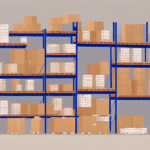Introduction to Packing Materials
When it comes to shipping or moving items, choosing the right packing material is of utmost importance. The correct materials not only ensure that your items arrive safely but also contribute to cost-effectiveness and sustainability. In this article, we’ll delve into the most commonly used packing materials, their pros and cons, eco-friendly alternatives, and future trends in packaging.
The Importance of Choosing the Right Packing Material
Selecting the appropriate packing material is crucial for protecting the contents of your shipment. The wrong choice can lead to damaged goods, increased shipping costs, and dissatisfied customers. Key factors to consider include the weight, fragility, and shape of the items being shipped.
- Protection: Ensures items remain intact during transit.
- Cost Efficiency: Reduces shipping costs by minimizing package weight.
- Sustainability: Choosing eco-friendly materials can enhance your brand’s reputation.
Types of Packing Materials
Cardboard Boxes
Cardboard boxes are a staple in the shipping industry due to their affordability and versatility. They come in various sizes and strengths, making them suitable for a wide range of items.
- Advantages:
- Affordable and widely available.
- Lightweight and recyclable.
- Customizable with prints and branding.
- Disadvantages:
- Prone to moisture damage.
- Limited insulation properties.
- Can lose strength if reused multiple times.
For more information on cardboard sustainability, visit the WWF website.
Bubble Wrap
Bubble wrap is renowned for its excellent cushioning and shock-absorbing qualities, making it ideal for fragile items.
- Advantages:
- Provides superior protection for delicate items.
- Lightweight and easy to use.
- Reusable and available in various sizes.
- Disadvantages:
- Made from non-biodegradable plastic.
- Can be bulky and difficult to store.
- Air pockets may burst, reducing effectiveness.
Learn more about alternatives to bubble wrap from the Packaging Europe.
Packing Peanuts
Packing peanuts are lightweight and versatile, ideal for filling void spaces and providing additional cushioning.
- Advantages:
- Lightweight and cost-effective.
- Conforms to the shape of the item for better protection.
- Disadvantages:
- Environmental concerns due to non-biodegradable options.
- Messy and can be a choking hazard for children and pets.
- Limited insulation properties.
Explore eco-friendly alternatives like biodegradable peanuts on the Biodegradable Packaging Network.
Foam Sheets
Foam sheets are used to protect items from scratches and dings. They come in various thicknesses and types to suit different needs.
- Advantages:
- Provides excellent protection against scratches and minor impacts.
- Offers insulation for temperature-sensitive items.
- Available in different types like polyethylene and polyurethane.
- Disadvantages:
- Can be more expensive than other materials.
- Less readily available in some regions.
- Time-consuming to cut and fit for large shipments.
For a deeper understanding of foam sheet types, refer to the Foam Alliance.
Plastic Containers
Plastic containers are durable and reusable, offering excellent protection against moisture and damage.
- Advantages:
- Reusable and long-lasting.
- Provides superior protection against moisture.
- Available in a wide range of sizes and shapes.
- Disadvantages:
- Higher upfront cost compared to disposable materials.
- Rigid structure may not accommodate oddly-shaped items.
Discover sustainable practices for using plastic containers at the EPA Sustainable Packaging page.
Eco-Friendly Packaging Options
Biodegradable Packing Materials
Biodegradable packing materials offer a sustainable alternative to traditional options. Materials such as corn starch packing peanuts and mushroom-based packaging break down naturally, reducing environmental impact.
- Advantages:
- Reduces environmental footprint.
- Compostable in appropriate conditions.
- Supports corporate sustainability goals.
- Disadvantages:
- May require specific disposal conditions to biodegrade effectively.
- Can be more expensive than conventional materials.
- Availability may be limited in some areas.
See the latest trends in biodegradable packaging at the Biocomposites Magazine.
Innovative Sustainable Materials
The packaging industry is embracing innovation with materials derived from natural sources like mushrooms, seaweed, and even recycled waste. These materials not only protect products but also minimize environmental impact.
- Advantages:
- Highly sustainable and renewable.
- Often biodegradable or compostable.
- Unique properties tailored for specific packaging needs.
- Disadvantages:
- Still in the early stages of widespread adoption.
- Higher production costs compared to traditional materials.
- May require new manufacturing processes.
Learn about cutting-edge sustainable packaging innovations on the Packaging Digest.
Best Practices for Shipping Fragile Items
Shipping fragile items requires meticulous planning and the right materials to ensure they arrive undamaged. Here are some best practices:
- Use Appropriate Cushioning: Materials like bubble wrap, foam sheets, and packing peanuts provide essential cushioning.
- Choose the Right Box: Select a sturdy box that can support the weight and shape of the item.
- Double Boxing: For extremely fragile items, place the item in one box, then place that box inside a second box with additional padding.
- Secure Packaging: Use strong packing tape to seal boxes and prevent them from opening during transit.
- Labeling: Clearly mark boxes containing fragile items with labels like "Fragile" and "Handle with Care."
For comprehensive guidelines, refer to the UPS Shipping Fragile Items page.
Future Trends in Packaging Materials
The packaging industry is rapidly evolving with a focus on sustainability, efficiency, and innovation. Here are some emerging trends:
- Compostable Packaging: Materials that break down naturally in composting environments.
- Reusable Packaging: Durable containers designed for multiple uses, reducing the need for single-use materials.
- Smart Packaging: Incorporation of technology like QR codes and RFID tags for better tracking and customer engagement.
- Minimalist Packaging: Reducing material usage to decrease waste and improve sustainability.
- Bio-Based Plastics: Development of plastics derived from renewable sources like plants.
Stay updated with the latest packaging innovations on the Packaging Insights platform.
Conclusion: Making the Right Choice for Your Needs
Choosing the right packing material is essential for ensuring that your items arrive safely, while also considering cost, sustainability, and efficiency. By understanding the advantages and disadvantages of each material and staying informed about eco-friendly alternatives, you can make informed decisions that benefit both your business and the environment.
For further reading and resources on optimal packing strategies, visit ShipScience.






















